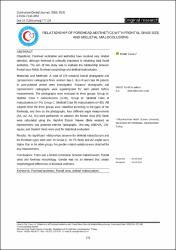| dc.contributor.author | Camcı, Hasan | |
| dc.date.accessioned | 2022-04-28T12:38:17Z | |
| dc.date.available | 2022-04-28T12:38:17Z | |
| dc.date.issued | 2020 | en_US |
| dc.identifier.citation | %0 Cumhuriyet Dental Journal RELATIONSHIP OF FOREHEAD AESTHETICS WITH FRONTAL SINUS SIZE AND SKELETAL MALOCCLUSIONS %A Hasan Camcı %T RELATIONSHIP OF FOREHEAD AESTHETICS WITH FRONTAL SINUS SIZE AND SKELETAL MALOCCLUSIONS %D 2020 %J Cumhuriyet Dental Journal %P 1302-5805-2146-2852 %V 23 %N 4 %R doi: 10.7126/cumudj.777128 %U 10.7126/cumudj.777128 | en_US |
| dc.identifier.issn | 2146-2852 | |
| dc.identifier.uri | https://doi.org/10.7126/cumudj.777128 | |
| dc.identifier.uri | https://hdl.handle.net/20.500.12933/859 | |
| dc.description.abstract | Introduction Forehead inclination and aesthetics have received very limited attention, although forehead is critically important in obtaining total facial aesthetics. The aim of this study was to evaluate the relationship between frontal sinus fields, forehead morphology, and skeletal malocclusion. Materials and Methods A total of 224 extraoral lateral photographs and cephalometric radiographs from skeletal class I, class II and class III patients in the post-pubertal period were investigated. Extraoral photographs and cephalometric radiographs were superimposed for each patient before measurements. The photographs were evaluated in three groups: Group A: Skeletal Class I malocclusions (n = 85), Group B: Skeletal Class II malocclusions (n = 74), Group C: Skeletal Class III malocclusions (n = 65). All subjects from the three groups were classified according to the types of the foreheads, and then on the photographs, four different angle measurements (A1, A2, A3, A4) were performed. In addition, the frontal sinus (FS) fields were calculated using the RadiAnt Dicom Viewer (Beta version) on cephalometric and posterior-anterior radiographs. One-way ANOVA, Chi-square, and Student t tests were used for statistical evaluation. Results No significant relationships between the skeletal malocclusions and the forehead types were seen. In Group C, the FS fields and A2 angles were higher than in the other groups. No gender-related variations were detected for any measurements. Conclusion There was a limited correlation between malocclusions, frontal sinus, and forehead morphology. Gender was not an element that creates morphological differences in forehead aesthetics. | en_US |
| dc.language.iso | eng | en_US |
| dc.publisher | Sivas Cumhuriyet Üniversitesi | en_US |
| dc.relation.isversionof | 10.7126/cumudj.777128 | en_US |
| dc.rights | info:eu-repo/semantics/openAccess | en_US |
| dc.subject | Forehead aesthetics | en_US |
| dc.subject | frontal sinus | en_US |
| dc.subject | skeletal malocclusions | en_US |
| dc.title | Relationship of forehead aesthetics with frontal sinus size and skeletal malocclusions | en_US |
| dc.type | article | en_US |
| dc.authorid | 0000-0003-0824-4192 | en_US |
| dc.department | AFSÜ, Diş Hekimliği Fakültesi, Klinik Bilimler Bölümü | en_US |
| dc.contributor.institutionauthor | Camcı, Hasan | |
| dc.identifier.volume | 23 | en_US |
| dc.identifier.issue | 4 | en_US |
| dc.identifier.startpage | 273 | en_US |
| dc.identifier.endpage | 282 | en_US |
| dc.relation.journal | Cumhuriyet Dental Journal | en_US |
| dc.relation.publicationcategory | Makale - Uluslararası Hakemli Dergi - Kurum Öğretim Elemanı | en_US |
















